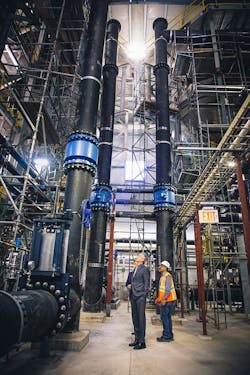MWRD, Ostara Open World's Largest Nutrient Recovery Facility
The Metropolitan Water Reclamation District of Greater Chicago (MWRD) in partnership with Ostara Nutrient Recovery Technologies officially opened the world’s largest nutrient recovery facility at their Stickney Water Reclamation Plant in Cicero, Ill.
MWRD’s new nutrient recovery facility is an example of how progressive technology can be implemented to transform a wastewater treatment facility into a resource recovery center, providing significant environmental benefits to the Chicago Area Waterway System and downstream to the Mississippi River and the Gulf of Mexico. Through Ostara’s technology, phosphorus and nitrogen will be recovered to create a high value fertilizer with a process that is both economically and environmentally viable. By removing phosphorus from where it should not be—in the water—and returning it to where it should be, available to farmers, this facility represents a significant shift in the wastewater industry from treatment to recovery for reuse.
MWRD Board of Commissioners President Mariyana Spyropoulos and Environmental Advocate and Attorney Robert F. Kennedy, Jr. joined U.S. Environmental Protection Agency Acting Regional Administrator Robert Kaplan; Deputy Mayor of Chicago Steve Koch; and President and CEO of Ostara, Phillip Abrary, to officially open the facility following a brief ceremony.
“To see the largest wastewater treatment facility in the world implement Ostara’s system is proof to municipalities there exists a viable and cost-effective solution to address their nutrient challenges,” said Kennedy in his keynote remarks, “Having a solution to solve plant issues while addressing more global challenges affecting the nation’s watersheds, without economic burden, is progress for the environment, ratepayers and future generations.”
"The MWRD is dedicated to becoming the utility of the future," said Spyropoulos. "Ostara’s technology is a solution to managing the overabundance of phosphorus while creating a revenue stream through the sale of the fertilizer. This is a win for the environment and a win for Cook County taxpayers."
Nutrient pollution is among the biggest environmental problems of the 21st century. Excess phosphorus in waterways can cause algae to grow and bloom, creating toxic conditions that destroy aquatic life and severely limit recreational enjoyment of lakes and rivers. Phosphorus is considered a major contributor to nutrient pollution, entering bodies of water from a number of sources including urban water treatment facilities. The MWRD’s nutrient recovery facility will greatly reduce its nutrient effluent load to the Chicago/Calumet river system, upstream of the Mississippi river basin and as a result, will reduce its impact on hypoxia in the Gulf of Mexico.
Designed to treat up to 1.44 billion gpd and serving a population equivalent to 4.5 million residents including the central part of Chicago and 43 suburban communities, the Stickney WRP discharges into the Chicago and Sanitary and Ship Canal, making it the largest water reclamation plant in the world. MWRD’s mission is to protect the water supply source, improve the quality of area waterways, and protect businesses and homes from flood damages while sustainably managing this vital resource for the Greater Chicago area.
Facing more stringent regulatory limits affecting effluent discharge permits in addition to a wastewater system that was experiencing an accumulation of mineral in struvite form, MWRD sought a closed-loop and cost-effective phosphorus management strategy. Ostara provided MWRD a solution to their challenges.
“For Ostara, partnering with MWRD is a milestone in successfully scaling up our technology to serve the largest wastewater treatment facility in the world, providing a cost effective and environmentally progressive solution to support their clean water mandate,” said Abrary. “We are proud to be part of a solution that will ultimately help protect the Mississippi River Basin, and provide revenue to the district from the sale of the high value phosphorus fertilizer recovered to benefit ratepayers.”
Enhanced Plant Efficiency
Ostara’s Pearl process for nutrient recovery is based on a closed-loop solution where nutrients such as phosphorus and nitrogen in wastewater are recovered to form a high value fertilizer that generates revenues for wastewater treatment facilities while helping meet environmental regulations.
Traditionally, when wastewater treatment plants remove phosphorus from their discharge stream, the nutrients are recycled back into their system, creating a new problem of nutrient scale, called struvite. The struvite not only clogs pipes and valves, reducing flow, but also requires costly maintenance. Although chemical additives can temporarily relieve struvite problems, it is a costly solution that also generates solid waste requiring disposal. Most wastewater treatment facilities are also facing increasingly stringent nutrient limits, enforced by the Environmental Protection Agency, to reduce nutrient pollution in adjacent waterways.
By recovering nutrients from the treatment facility’s wastewater stream and converting them to slow-release fertilizer, Ostara’s technology helps MWRD increase operational inefficiencies by avoiding struvite build up, and protecting the local watershed.
The Pearl process can recover more than 85% of the phosphorus and up to 15% of the nitrogen from wastewater streams before they accumulate as struvite in pipes and equipment.
As the largest nutrient recovery facility in the world, MWRD has installed three of Ostara’s Pearl 10000 reactors, with an installed production capacity of up to 10 tons of Crystal Green per day. The district will receive revenue for every ton of fertilizer it produces.
The MWRD’s new nutrient recovery facility will create annual cost savings in chemicals, solid waste disposal, maintenance and power. Following the successful commercial start-up of this facility, the MWRD plans to implement WASSTRIP, a process that turbo-charges the nutrient recovery process and increases the amount of phosphorus recovered by more than 60%. As a result, the efficiency of the Pearl process will be further enhanced to decrease the magnitude of struvite scale formation and alleviate operational issues.
Source: MWRD
